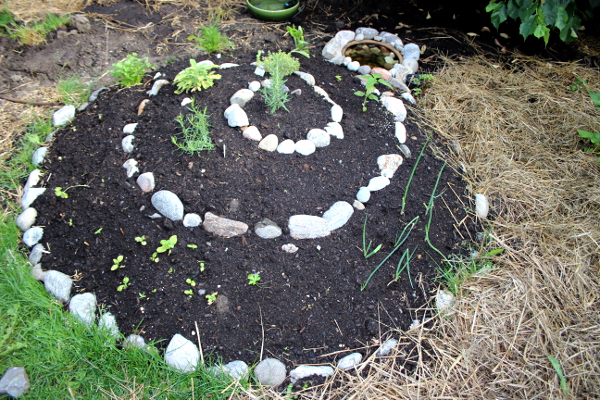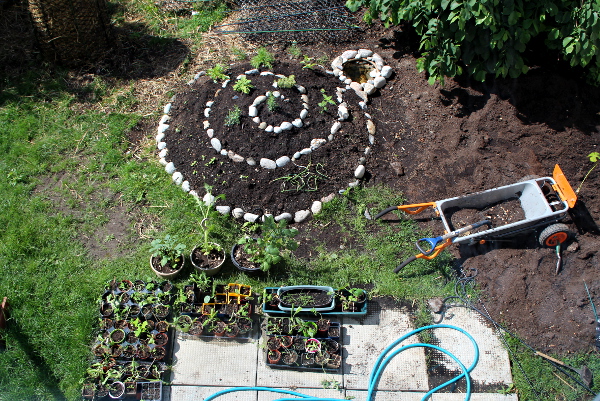We have moved to a new place at the end of May, which means I have a new garden to shape. I have decided to try my hand at a permaculture herb spiral. The result looks lovely and the herbs seem happy.
Our back yard is larger than the previous outdoor space we had, but there is a play structure, existing shrubbery, and three small trees, so I have to work around those. The soil is very sticky, full of clay and rocks which makes digging very difficult. These factors have stirred me towards rebuilding two of my permaculture towers to take advantage of vertical growing space and the fertile soil in the towers. I have also put in a few plants at the front (disturbing the manicured lawn), a few along the far fence at the back, and a lettuce patch at the side of the house.
My experiment this year is the permaculture herb spiral. Last year, most of my herbs got overpowered by tomatoes and were far out of reach in the deep tomato forest. So, this year, I have decided to still plant some companion herbs and plants together (such as cucumbers and dill), while building the herb spiral to make the herbs more accessible and able to really thrive. I got the inspiration and theoretical basis for it online, and, as we were packing and moving, have arranged for the soil to be delivered and set out on an adventure with the kids to pick our river rocks and a few other supplies at a landscaping supply place.
Here is a classical illustration of a permaculture herb spiral:
A permaculture herb spiral is aesthetically pleasing and, if done correctly, provides several micro-climates, each favouring different herbs, by combining elevation, soil composition, moisture retention, and sun exposure.
First, I have collected the supplies
- Organic soil – a combination of peat moss, manure, black peat loam and mushroom compost, for the bulk of the spiral
- Sand to mix into the soil for the top part
- Gravel to fill up the bottom of the middle pillar
- Water-polished river rocks for walls
- Ceramic pot and a wine bottle cork for the pond
- Organic plant seedlings:
- Chamomile
- Calendula
- Tarragon
- Rosemary
- Summer or winter sage
- Thyme (lemon thyme if possible)
- Coriander
- Bergamot
- Parsley
- Basil
- Thai Chili peppers
- Green onions
- Watercress (alas, my organic seedling source did not have any)
Then I set out to build the spiral
- Measure out a circle about 2 meters in diameter, with a string tied to a stick. Mark the circumference with a few river rocks.
- Lay out cardboard in a circle, to prevent grass from growing into the spiral (the back yard appears to have been a lawn before).
- Dig a pit for the pond and set the ceramic pot into it.
- Lay out the full circle with river rocks, spiraling in, to create three levels of elevation. My son loved helping me out with this part.
- Fill up the space between rocks with soil, slowly building upwards. In the middle, put gravel instead of soil, so that the middle pillar of the spiral drains faster. Keep building up the inner walls so that the middle walls gradually rise higher than the bottom level. Use the soil to support the rock walls as they are being built.
- Mix soil with sand to fill up the top of the middle pillar. Mediterranean herbs like sandy fast-draining soil.
- Plug the ceramic pot with the cork, so it retains water.
- Lay river rocks around the pond and inside of the ceramic pot, creating layered rocky bottom for the pond. If frogs are ever introduced, they will find it welcoming. A small pot with watercress can be nestling in the damp rocks.
- Fill up the pond with water to the brim.
- Plant the seedlings — dry-loving ones at the top, spiraling down to the most moisture-loving ones.
Here is the result
From the top, following the spiral, I have rosemary, lemon thyme, golden sage, tarragon, bergamot, calendula, chamomile, and cilantro from purchased seedlings, followed by Thai chili peppers, a variety of basil, parsley and onions sprouted in my old basement. I have also placed some mint in a pot near the water so that it doesn’t take over the spiral as mint will, and have seeded Persian cress around the pond.
I have purchased lemon grass and lemon verbena, but have decided against planting them in the spiral, since they grow quite tall. Instead, I have planted them around the porch, to help stave off insects. Last year, they grew very tall and made for quite a few cups of delicious tea.
The view of the spiral is lovely from the kitchen and from the second floor window. It makes for a fun project to do with the kids, to watch the plants grow and observe the life in the pond.








